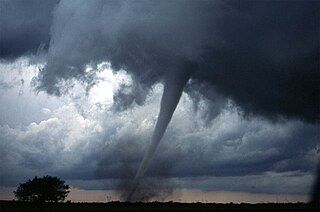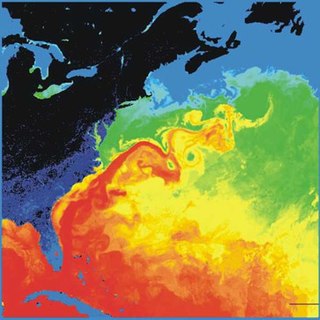Related Research Articles

Jet streams are fast flowing, narrow, meandering air currents in the atmospheres of the Earth, Venus, Jupiter, Saturn, Uranus, and Neptune. On Earth, the main jet streams are located near the altitude of the tropopause and are westerly winds. Jet streams may start, stop, split into two or more parts, combine into one stream, or flow in various directions including opposite to the direction of the remainder of the jet.

Extreme weather includes unexpected, unusual, severe, or unseasonal weather; weather at the extremes of the historical distribution—the range that has been seen in the past. Extreme events are based on a location's recorded weather history. They are defined as lying in the most unusual ten percent. The main types of extreme weather include heat waves, cold waves and heavy precipitation or storm events, such as tropical cyclones. The effects of extreme weather events are economic costs, loss of human lives, droughts, floods, landslides. Severe weather is a particular type of extreme weather which poses risks to life and property.

Bert Rickard Johannes Bolin was a Swedish meteorologist who served as the first chairman of the Intergovernmental Panel on Climate Change (IPCC), from 1988 to 1997. He was professor of meteorology at Stockholm University from 1961 until his retirement in 1990.

The instrumental temperature record is a record of temperatures within Earth's climate based on direct measurement of air temperature and ocean temperature. Instrumental temperature records do not use indirect reconstructions using climate proxy data such as from tree rings and marine sediments. Instead, data is collected from thousands of meteorological stations, buoys and ships around the globe. Areas that are densely populated tend have a high density of measurements points. In contrast, temperature observations are more spread out in sparsely populated areas such as polar regions and deserts, as well as in many regions of Africa and South America. In the past, thermometers were read manually to record temperatures. Nowadays, measurements are usually connected with electronic sensors which transmit data automatically. Surface temperature data is usually presented as anomalies rather than as absolute values. A temperature anomaly is presented compared to a reference value, also called baseline period or long-term average). For example, a commonly used baseline period is the time period from 1951 to 1980.

In meteorology, a low-pressure area, low area or low is a region where the atmospheric pressure is lower than that of surrounding locations. Low-pressure areas are commonly associated with inclement weather, while high-pressure areas are associated with lighter winds and clear skies. Winds circle anti-clockwise around lows in the northern hemisphere, and clockwise in the southern hemisphere, due to opposing Coriolis forces. Low-pressure systems form under areas of wind divergence that occur in the upper levels of the atmosphere (aloft). The formation process of a low-pressure area is known as cyclogenesis. In meteorology, atmospheric divergence aloft occurs in two kinds of places:

Kevin Edward Trenberth worked as a climate scientist in the Climate Analysis Section at the US National Center for Atmospheric Research (NCAR). He was a lead author of the 1995, 2001 and 2007 IPCC assessment reports. He also played major roles in the World Climate Research Programme (WCRP), for example in its Tropical Oceans Global Atmosphere program (TOGA), the Climate Variability and Predictability (CLIVAR) program, and the Global Energy and Water Exchanges (GEWEX) project.

William "Bill" Mason Gray was emeritus professor of atmospheric science at Colorado State University (CSU), and the head of the Tropical Meteorology Project at CSU's Department of Atmospheric Sciences. He is widely regarded as a pioneer in the science of tropical cyclone forecasting and one of the world's leading experts on tropical storms. After retiring as a faculty member at CSU in 2005, Gray remained actively involved in both climate change and tropical cyclone research until his death.

Jule Gregory Charney was an American meteorologist who played an important role in developing numerical weather prediction and increasing understanding of the general circulation of the atmosphere by devising a series of increasingly sophisticated mathematical models of the atmosphere. His work was the driving force behind many national and international weather initiatives and programs.
This is a list of meteorology topics. The terms relate to meteorology, the interdisciplinary scientific study of the atmosphere that focuses on weather processes and forecasting.

Joseph Smagorinsky was an American meteorologist and the first director of the National Oceanic and Atmospheric Administration (NOAA)'s Geophysical Fluid Dynamics Laboratory (GFDL).

Christopher William "Chris" Landsea is an American meteorologist, formerly a research meteorologist with the Hurricane Research Division of the Atlantic Oceanographic and Meteorological Laboratory at NOAA, and now the Science and Operations Officer at the National Hurricane Center. He is a member of the American Geophysical Union and the American Meteorological Society.

A tropical cyclone is a rapidly rotating storm system with a low-pressure center, a closed low-level atmospheric circulation, strong winds, and a spiral arrangement of thunderstorms that produce heavy rain and squalls. Depending on its location and strength, a tropical cyclone is called a hurricane, typhoon, tropical storm, cyclonic storm, tropical depression, or simply cyclone. A hurricane is a strong tropical cyclone that occurs in the Atlantic Ocean or northeastern Pacific Ocean, and a typhoon occurs in the northwestern Pacific Ocean. In the Indian Ocean and South Pacific, comparable storms are referred to as "tropical cyclones". In modern times, on average around 80 to 90 named tropical cyclones form each year around the world, over half of which develop hurricane-force winds of 65 kn or more. Tropical cyclones carry heat away from the tropics and transport it towards temperate latitudes. This plays an important role in regulating global climate. Tropical cyclones can be very harmful for people.

Jagadish Shukla is an Indian meteorologist and Distinguished University Professor at George Mason University in the United States.

Rain is water droplets that have condensed from atmospheric water vapor and then fall under gravity. Rain is a major component of the water cycle and is responsible for depositing most of the fresh water on the Earth. It provides water for hydroelectric power plants, crop irrigation, and suitable conditions for many types of ecosystems.

The Gulf Stream is a warm and swift Atlantic ocean current that originates in the Gulf of Mexico and flows through the Straits of Florida and up the eastern coastline of the United States, then veers east near 36°N latitude and moves toward Northwest Europe as the North Atlantic Current. The process of western intensification causes the Gulf Stream to be a northward-accelerating current off the east coast of North America. Around 40°0′N30°0′W, it splits in two, with the northern stream, the North Atlantic Drift, crossing to Northern Europe and the southern stream, the Canary Current, recirculating off West Africa.
International Cloud Experiment was a scientific mission to gather information on tropical storm formation. It involved seven airplanes, a ship anchored off Darwin in Australia, RV Southern Surveyor, and over 250 scientists and researchers.

Joachim Kuettner, also spelled Küttner, was a German-American atmospheric scientist.
Paul Rowland Julian, a Fellow of the American Meteorological Society, is an American meteorologist who served as a longtime staff scientist at the National Center for Atmospheric Research (NCAR), was co-author with Roland Madden of the study establishing the Madden–Julian oscillation (MJO), and contributed to the international, multi-institutional Global Atmospheric Research Program (GARP), Tropical Wind, Energy Conversion, and Reference Level Experiment (TWERLE), and Tropical Ocean-Global Atmosphere (TOGA) meteorology research programs. The MJO meteorologic phenomenon he co-discovered is the largest element of the intraseasonal variability in the tropical atmosphere, a traveling pattern arising from large-scale coupling between atmospheric circulation and tropical deep convection. Description of the MJO remains an important contribution to climate research with relevance to modern short- and long-term weather and climate modeling.
Margaret Anne LeMone is an atmospheric scientist who uses both atmospheric observations and computer models to study the formation and development of clouds, the development of precipitation, and the structure of storms.
Roland Aloysius Madden, an American meteorologist, was a staff scientist at the National Center for Atmospheric Research (NCAR) from 1967 to 2002. His research centers on diagnostic studies of the atmosphere. Madden is a fellow of the American Meteorological Society (AMS) and a recipient of the 2002 Jule G. Charney Award of the AMS.
References
- ↑ American Meteorological Society
- Barron, Eric J. (1992) A Decade of International Climate Research: The First Ten Years of World Climate Research Program US National Academies Press pages 1-2
- Weart, Spencer R. (2003) The Discovery of Global Warming Harvard University Press ISBN 9780674011571 pages 99-100
- Philander, S. George (2012) Encyclopedia of Global Warming and Climate Change [ permanent dead link ] SAGE Publications ISBN 9781412992626 page 634